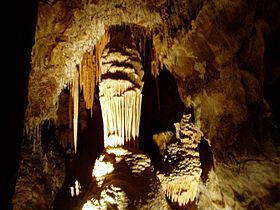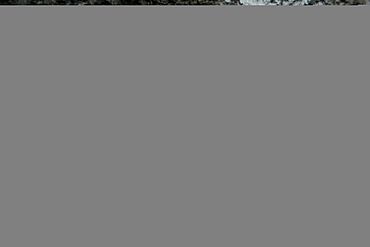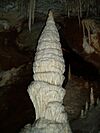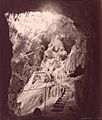Jenolan Caves facts for kids
Quick facts for kids Jenolan Caves |
|
|---|---|
| Tharawal: Binoomea, Bindo, Binda Fish River Caves |
|

The Grand Column
|
|
| Location | Oberon, New South Wales, Australia |
| Discovery |
|
| Geology | Limestone |
| Entrances | 300 |
| Access | Public; eleven show caves open daily |
| Lighting | LED |
| Website | http://www.jenolancaves.org.au/ |
| UNESCO World Heritage Site | |
| Official name | Greater Blue Mountains Area |
| Location | New South Wales, Australia |
| Part of | Greater Blue Mountains Area |
| Criteria | Natural: (ix), (x) |
| Inscription | 2000 (24th Session) |
| Area | 1,032,649 ha (2,551,730 acres) |
| Buffer zone | 86,200 ha (213,000 acres) |
| Official name: Jenolan Caves, Jenolan Caves Rd, Oberon, NSW, Australia | |
| Type: | Natural |
| Designated: | undated |
| Part of: | Greater Blue Mountains Area UNESCO World Heritage List |
| Reference #: | 106242 |
| Place File No.: | 1/07/236/0007 |
| Area: | 145 hectares (360 acres) |
| Jenolan Karst Conservation Reserve New South Wales |
|
|---|---|
|
IUCN Category III (Natural Monument)
|
|

The Imperial Cave at Jenolan Caves
|
|
| Nearest town or city | Oberon |
| Established | 6 December 1997 |
| Area | 30.83 km2 (11.9 sq mi) |
| Managing authorities |
|
| Official name: Jenolan Caves Reserve; Binoomea; Binda Caves; Fish River Caves; McKeon's Caves; McEwan's Creek Caves; Bendo Caves; Jenolan Karst Conservation Reserve | |
| Type: | State heritage (landscape) |
| Designated: | 25 June 2004 |
| Reference #: | 1698 |
| Type: | Cave |
| Category: | Landscape – Natural |
| Website | Jenolan Karst Conservation Reserve |
| See also | Protected areas of New South Wales |
The Jenolan Caves are amazing limestone caves in New South Wales, Australia. They are also known by their Aboriginal names: Binoomea, Bindo, or Binda. These caves are found in the Jenolan Karst Conservation Reserve. This reserve is west of the Blue Mountains.
The caves are about 175 kilometres (109 mi) west of Sydney. They are also 20 kilometres (12 mi) east of Oberon. These caves are super old, formed about 340 million years ago! This makes them the oldest known open cave system in the world.
Jenolan Caves are the most popular caves to visit in Australia. They are famous for their beautiful calcite formations. These formations are sometimes pure white. The caves also have many Silurian marine fossils. The cave system follows an underground part of the Jenolan River. It has over 40 kilometres (25 mi) of passages and more than 300 entrances. Scientists are still exploring new parts!
You can visit eleven show caves that are lit up. The caves and the reserve are part of the UNESCO World Heritage-listed Greater Blue Mountains Area. This means they are very important to protect.
Contents
What's in a Name?
The name Jenolan likely comes from an Aboriginal word. It means "high place." It might come from the Tharawal word Genowlan. This word describes a "high place shaped like a foot."
History of Jenolan Caves
How the Caves Formed
Scientists have studied the clay inside the caves. They measured tiny amounts of radioactive potassium and argon gas. This helped them figure out the age of the clay. They found the clay is about 340 million years old! This makes Jenolan the oldest known open cave system on Earth. The Commonwealth Scientific and Industrial Research Organisation (CSIRO) helps lead this research. They work with the University of Sydney and the Australian Museum.
Aboriginal Culture and the Caves
For thousands of years, the Jenolan area has been special to local Aboriginal people. The Gundungurra and Wiradjuri peoples called it Binomil or Bin-oo-mur. They have a Dreamtime story about how the land was made. It tells of a fight between two spirits: Gurangatch, a giant eel, and Mirrigan, a large native cat. The Gundungurra people used to go into the caves. They would take sick people to bathe in the underground water. They believed this water had healing powers.
European Discovery of the Caves
We don't have exact records of when Europeans first found the caves. But James Whalan is usually given credit for discovering them. This happened around 1838 or 1841. James was looking for someone who had taken some things. During his search, he found the amazing cave system. He told his brother Charles, who explored the caves more.
The caves were first called the Fish River Caves. In 1866, the NSW Government took control of them. This made them one of the first places in the world protected for conservation. Jeremiah Wilson became the first "Keeper of the Caves" in 1867. He explored and found many new caves, like the Imperial and Jubilee Caves.
At first, visitors could take souvenirs and write on the cave walls. But this was stopped in 1872 to protect the caves. In 1884, the name Jenolan Caves was officially adopted.
Getting to the caves used to be very hard. In the 1880s, a new horse-and-carriage track was built. It was called the Six Foot Track. This made it much easier for people to visit. The Governor of New South Wales, Lord Carrington, was the first to travel this new track in 1887.
In 1898, the famous Jenolan Caves House was built. It replaced an older building that had burned down. J. C. (Voss) Wiburd became the "Keeper of the Caves" in 1903. He and his friend Jack Edwards discovered five more caves! These included the River, Orient, and Ribbon Caves.
The Chifley Cave was renamed in 1952. This was to honor Ben Chifley, a former Prime Minister. In 1968, the Orient Cave was the first cave in the world to be cleaned. It had gotten dirty from mud and soot. Today, if caves need cleaning, they use water from the caves' own underground rivers. This protects the delicate crystal formations.
Since 2011, scientists have used new 3D mapping systems. This helps them create detailed maps of the caves.
Exploring the Caves
Many parts of the Jenolan Caves are only for experienced cavers. These include areas along the underground river. But eleven show caves are open for everyone to visit!
| Cave name | European discovery | Image | Accessibility | Lighting | Description | Source(s) |
|---|---|---|---|---|---|---|
| Lucas | 1860 | Very popular for visitors | LED | Named after John Lucas MP. He helped protect the caves. This cave has huge rooms, like the Cathedral, which is over 50 metres (160 ft) high. The Cathedral is also used for weddings and music concerts because of its great sound. | ||
| River | 1903 | A big show cave; the most challenging walk | LED | This cave has famous features like the Minaret and the Grand Column. It also includes part of the River Styx. Before 1923, you had to cross a section of the river by boat! | ||
| Chifley | 1880 | A large show cave | LED | The Chifley Cave was the first cave in the world to have electric lights, back in 1880! Two rooms still have historic colored lights. | ||
| Imperial | 1879 | Easy to walk through for tourists | LED | The Imperial Cave has some of the best fossils. You can even find Tasmanian devil bones here. The rock itself is full of marine fossils, even if you can't easily see them. | ||
| Orient | 1904 | Opened to public in 1917 | LED | This cave has some of the biggest and most beautiful formations. It was steam cleaned in 1968 to keep them safe. In 2009, new LED lights were installed here. | ||
| Ribbon | 1904 | LED | The Ribbon Cave is 60 metres (200 ft) long and is very decorated. It's known for amazing 'ribbon' Helictites. | |||
| Pool of Cerberus | 1903 | LED | This cave is a lower part of the River Cave. It has the beautiful Bath of Venus and part of the underground river. You can also see rare aragonite formations here. | |||
| Jubilee | 1893 | LED | The Jubilee Cave is the longest show cave at Jenolan. It takes the longest time to visit. It's less visited because the tours are longer and groups are smaller. | |||
| Temple of Baal | 1904 | LED | This cave has two large rooms. One room has a huge 9-meter shawl formation called the Angel's Wing. It also has many unique Helictites. The name comes from old stories and mythology. | |||
| Nettle Cave | 1838 | Self–guided audio tour | LED | The Nettle Cave is between the Grand Arch and the Devils Coach House. It's named after plants that grow near its entrance. Raised paths keep visitors safe from stings. This cave has "Crayfish backs," which are stromatolites shaped by tiny living things. They are at least 20,000 years old! | ||
| The Grand Arch | 1838 | Meeting point for tours | The road goes right through this huge arch. Many cave tours start here. Next to it is the Devil's Coach House, a giant open cave. High above is Carlotta Arch, a natural rock arch. | |||
| Elder Cave | 1848 | Adventure caving | This was one of the first caves found and opened for tourists. It was later closed but reopened for adventure caving. It's called the Plughole Tour now. You can see signatures from early visitors here. | |||
| Aladdin Cave | 1897 | The Aladdin Cave was explored to find a shorter way to the Jubilee Cave. It has similar beautiful decorations. | ||||
| Jersey Cave | 1891 | This cave is an extension of the Elder Cave. A cool feature here is a fossilized thylacine (Tasmanian tiger) skeleton! | ||||
| Arch Cave | 1838 | This cave is above Nettle Cave. You can see part of it from the Devils Coach House. The entrance is at the bottom of Carlotta Arch. | ||||
Visiting Jenolan Caves
Jenolan Caves are about a three-hour drive from Sydney and Canberra. You can also take a private bus tour from Sydney or Katoomba railway station. There is no public transport directly to the caves. Over 250,000 people visit each year! This makes it a very popular spot in rural New South Wales.
Long ago, the only way to get to the caves was the Six Foot Track. This was a 45 kilometres (28 mi) long path from Katoomba. It's now a popular bushwalking track for overnight trips.
Ten of the "dark caves" offer guided tours every day. These tours usually last 1 to 2 hours. The group sizes change for each cave. For example, the small Pool of Cerberus Cave only allows 8 people per tour. But the huge Lucas Cave can have up to 65 people.
Tours have different difficulty levels. The Imperial Cave has the fewest stairs. The River Cave is the most challenging walk. Most visitors can enjoy any of these show caves.
You can also take a self-guided audio tour of the Nettle Cave and Devils Coach House. This tour offers many languages, including an Aboriginal culture commentary.
Night tours are usually only for guests staying at The Grand Jenolan Cave House. Sometimes, on Saturday nights, they offer special tours of caves not open during the day.
For those who love adventure, there are undeveloped caves for "adventure caving." These tours can last from 2 hours to a whole day. The Plughole Tour includes basic abseiling and runs daily. More challenging adventure tours are also available.
The Cathedral Chamber in the Lucas Cave is famous for its amazing sound. Underground concerts are held here. Concerts also happen in the Grand Arch, including the yearly 'Carols in the Caves'. This event raises money for charity.
During school holidays, there are special tours just for kids! Jenolan Caves has always been a popular place for school trips.
Jenolan Caves House
If you visit Jenolan Caves, you can stay at the historic Jenolan Caves House. It was built in 1897. It was designed as a fancy place for wealthy visitors. It even had a ballroom and a grand dining room, now called Chisolm's Restaurant. Chisolm's serves modern Australian food every night. The area has a hotel/motel, cottages, a restaurant, a bar, and a cafe.
Why Jenolan Caves are Special
Jenolan Caves Reserve is very important for its history, beauty, and scientific value. It was the first public reserve in NSW created to protect a natural place. This was done to save the Jenolan Caves.
The caves are loved for their beautiful formations. Names like Aladdin, Orient, and Temple of Baal caves show this beauty. The caves also show how technology has grown. They were the first in the world to use electric cave lighting in the 1880s. Australia's first hydro-electric power was also developed here. The setting of the caves, with the small village and Caves House surrounded by steep cliffs, is stunning. The entrance through the Grand Arch and the blue lake make it a truly unique and beautiful place.
The reserve helps us learn about the geology of NSW and Australia. It also has many rare plants and animals, especially inside the caves. It's home to the Greater sooty owl and the brush-tailed rock-wallaby. A unique spider-like creature, Holonuncia cavernicola, lives only in the Jenolan Caves. The reserve also has three rare or endangered plant species.
Jenolan is a very important place for both nature and history in Australia. It has one of the largest and most beautiful cave systems. The Jenolan River and Blue Lake create a wonderful home for native plants and animals. The Caves Reserve was created in 1866. Since its discovery, over three million people have visited. Caves House and other old buildings add to the area's history. You can also see Australia's first hydro-electric power station here. Plus, there are parts of the first electric lighting system from 1887 in the Chifley Cave.
Climate
| Climate data for Jenolan Caves | |||||||||||||
|---|---|---|---|---|---|---|---|---|---|---|---|---|---|
| Month | Jan | Feb | Mar | Apr | May | Jun | Jul | Aug | Sep | Oct | Nov | Dec | Year |
| Mean daily maximum °C (°F) | 25.6 (78.1) |
24.6 (76.3) |
21.8 (71.2) |
16.7 (62.1) |
12.8 (55.0) |
10.0 (50.0) |
9.4 (48.9) |
11.5 (52.7) |
15.3 (59.5) |
19.4 (66.9) |
22.4 (72.3) |
25.0 (77.0) |
17.9 (64.2) |
| Mean daily minimum °C (°F) | 11.6 (52.9) |
11.7 (53.1) |
10.0 (50.0) |
6.4 (43.5) |
3.2 (37.8) |
1.5 (34.7) |
0.2 (32.4) |
0.9 (33.6) |
2.9 (37.2) |
5.7 (42.3) |
8.1 (46.6) |
10.3 (50.5) |
6.0 (42.8) |
| Source: Australian Bureau of Meteorology | |||||||||||||
Images for kids
-
Historic hotel, Jenolan Caves House, offers a range of tourist accommodation
See also
- List of caves within the Jenolan Caves karst
- List of caves in New South Wales
- Protected areas of New South Wales
- Speleology
- Jenolan Caves Road

















